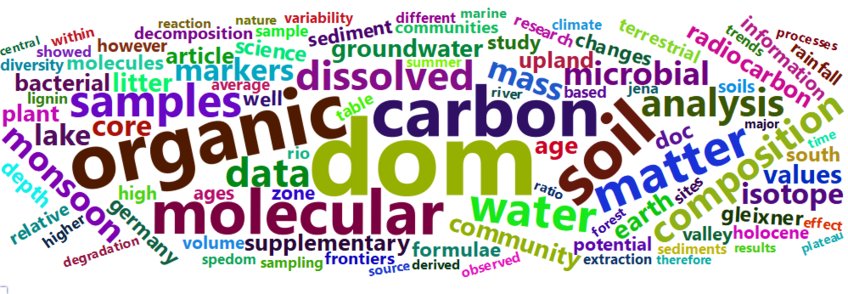
Projects of the Molecular Biogeochemistry Group
Focus 1: Understanding the origin, fate and stability of organic matter in the critical zone

Soil organic matter (SOM) remains the largest single unknown in the terrestrial carbon cycle. The group investigates in various projects how abiotic factors like organic matter input, parent material, humidity and temperature as well as biotic factors such as stand age, plant and microbial diversity influence SOM storage. The isotopic information of 13C,14C and 15N of biomarkers from individual compounds and fractions determines the molecular turnover of SOM and suggests high vulnerability of SOM stored in soils. We determine the molecular and isotopic composition of dissolved organic matter (DOM) in order to understand the role of DOM in the environment. We use the molecular fingerprints of DOM using ultrahigh resolution mass spectrometry to identify sources and evolution of organic matter. The isotopic content of DOC in soil depth profiles suggests that DOM from the surface is reactively transported in the soil and that DOM in deeper soil horizons is not related to the DOM in upper soil horizons.
Individual projects are part of the Collaborative Research Centre AquaDiva at the FSU Jena and the project "Molecular fingerprints of ecosystems" with the Zwillenberg-Tietz Stiftung.
Involved members:
- Postdoc Markus Lange
- Postdoc Simon Schroeter
- PhD candidate Alice Orme
- PhD candidate Arina Ivanova
- PhD candidate Chen Huang
Focus 2: Understanding carbon and nitrogen flow in the plant-microbial-soil continuum

Carbohydrates are the central molecules in plant metabolism. During the day, they transport energy and carbon fixed by photosynthesis to support respiration, storage, growth and defense. At night, they provide energy for the cellular metabolism using mitochondrial respiration. However, so far the regulation of carbohydrate metabolism and the role of different processes in plant metabolism is still not completely understood. The group develops and applies molecular techniques to use the isotopic information of plant metabolites to trace the flow of carbon in plants and to understand its regulation.
Involved members:
- PhD candidate Georg Dittmann
- PhD candidate Somak Chowdhury
Focus 3: Understanding the role of biodiversity on element cycling

Plants react not only to abiotic factors like climate, but also to the presence of other plants and microorganisms in the soil. The interaction can be positive if, for example, resources are used complementarily but also negative if pathogens are infecting plants. At the community level, these interactions are difficult to investigate. Molecular tools can help to differentiate between the responses of individual species and communities. Our work is focused on the effect of grassland diversity on (1) the link between above- and below- ground diversity; and (2) the link between plant diversity, soil organic matter (SOM) dynamics and export of dissolved organic matter. In short term experiments we use isotopic labeling to trace the effect of diversity on how carbon is allocated from plants to soil microorganisms and SOM (Ecotron Experiment). In the long term we investigate if higher plant diversity gives the insurance for a long term success of the community, even if some individual species of the community may fail (Jena Experiment).
Involved members:
- Postdoc Markus Lange
- PhD candidate Akanksha Rai
- PhD candidate Agata Garsia
Focus 4: Understanding and reconstructing past climate and vegetation dynamics

Understanding of the links between ecosystems and past and present climate will improve our prediction for future climates and how they may affect biodiversity and ecosystem function. Reconstructions of the Holocene climate are strongly linked to information from polar ice cores, while climate reconstructions for larger areas that permit separation of the effects of local climate effects from large-scale circulation patterns are still very sparse. The group explores the use of hydrogen isotopes of biomarkers as a proxy for palaeoclimate reconstructions. A major focus has been the construction of quantitative transfer functions that link hydrogen isotopes to the hydrologic cycle across humid, tropical, boreal and mountain ecosystems. These methods are now being applied to the large-scale climate reconstructions of monsoon variation in the past 10,000 years on the Tibetan plateau (TiP), Kyrgyzstan (CADY)and Sri Lanka.
Involved members:
- PhD candidate Kasun Gayantha
- PhD candidate Natalie Schröter



